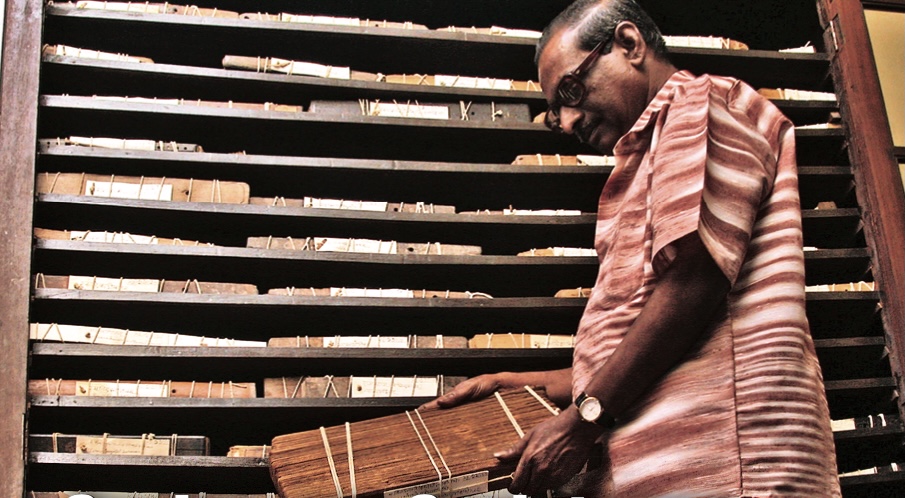WITH KESAVA MALLIA
“I just cannot sit idle” says S. Sambanda Sivacharyar of Cuddalore. “One day, if I don’t read or see a manuscript, that day I shall be very uncomfortable.” The white-bearded, wisened Sivacharyar has been with the French Institute of Pondicherry for 37 years, purchasing, organizing, cataloging and assisting with the critical editing and translation of ancient Saiva manuscripts. Even at 79, having authored five books on temple rituals himself, he’s not ready to retire. There is much work yet to be done to preserve and bring forth tens of thousands of texts which record the ritual and philosophical knowledge that has been locked within his Adisaiva priest tradition for millennia.
The French Institute of Pondicherry is a research institute of the French Ministry of Foreign Affairs. Most of the Institute’s activities fall into the areas of social sciences and ecology. The Indology department is working to preserve the subcontinent’s extraordinary heritage of ancient religious manuscripts, one of only a handful of such bodies in the world.
The collection began in 1955, shortly after the Institute’s founding, when Dr. Jean Filliozat, late founder-director of the Institute and director of the French School of the Far East, wished to explain the Hindu temple and what happens in it. He set out to collect as many of the materials he could find relating to South India’s rich Saivite tradition. Pandit N.R. Bhatt, 81, a scholar of the French School and now retired head of Indology at the Institute, spearheaded the collection effort in the late ’50s. The manuscripts were gathered from private collections of temples, priests and monasteries across South India. Bhatt scoured the Tamil countryside for Saiva manuscripts, sometimes bringing back entire collections that included many other categories of texts as well.
The Adisaivas, Tamil Nadu’s hereditary clan of Sivacharya temple priests, trustingly sold and sometimes gifted manuscripts, mostly in the form of palm-leaf bundles, which had been in their families for centuries. Sambanda Sivacharyar recalls, “In 1975, a priest in Chennai who was so poor willingly gave us a bag full of manuscripts unconditionally.” The Institute’s promise in return was to carefully protect and preserve, and eventually transcribe and translate, it all.
The Institute now has about 8,600 manuscripts transmitting approximately 60,000 texts. Jointly with the French School of the Far East, the total collection of over 11,000 manuscripts includes the world’s largest assemblage of texts of Hinduism’s Saiva Siddhanta tradition. More than half of these are Saiva Agamas, honored along with the Vedas as Hinduism’s revealed scriptures, and paddhatis, ritual manuals based on the Agamas.
Included in the collection are significant numbers of devotional hymns and legends about holy places, Vedic astrology texts, epics, myths and legends, traditional medical texts, Vedas and other literary works. Among the manuscripts, 6,850 are written in Sanskrit, 1,200 in Tamil, with others in Tulu, Telugu, Malayalam, Manipravalam (a combination of Malayalam and Sanskrit) and Kannada. The Sanskrit texts are inscribed in all of the nine Indian scripts used to write Sanskrit: Devanagari, Grantha, Tamil, Malayalam, Kannada, Nandinagari, Sarada (Kashmiri), Tulu and Nepali. In addition to plain text, there are Oriya manuscripts that have abundant drawings and diagrams. Some Tamil manuscripts show yantras, and a few Malayalam manuscripts show illustrations of the human body.
Most of the manuscripts–8,187, to be exact–are in the form of palm-leaf bundles as much as three centuries old. In addition to the palm-leaf bundles, there are 360 paper codices and 1,144 recent paper transcripts, hand copies of palm leaves that were made when the owners wouldn’t allow the leaves themselves to be taken.
The palm leaves come in a range of sizes, from the Ramayana Aaroodam at just a few inches across to one on the Saiva Agamas at 45 inches long. These leaves, onto which letters are incised with a stylus, can deteriorate quickly in South India’s climate. Many of them are perforated with holes left by insect larvae. They are so fragile that they are damaged each time they are handled; pieces break off, sometimes carrying with them fragments of writing. In an effort to preserve the leaves as long as possible, the collection’s unsung hero, Vimalanathan, spent two years methodically brushing them free of insect debris, applying lemongrass oil and placing the leaves in the hot sun to dry before restacking them.
Since the effort began in the 1950s, the Institute has published thirteen books translating seven of the 28 Saiva Agamas into French. More translations are underway, but the bulk of the department’s energy is currently being consumed in an effort to digitally photograph and catalog the entire manuscript collection. This is no easy task. Describing the texts contained in the manuscripts is difficult and tedious, considering that a single palm-leaf bundle can contain dozens of texts. The tiny letters are typically engraved without spaces between words or between where one text ends and another begins. There is not even any emphasis to indicate chapter titles.
Thus, this process is a slow one, requiring not only great physical care but intimate familiarity with Sanskrit scriptures. The Institute’s goal is to make the collection available in a searchable online database for anyone researching Saiva religion and philosophy. A pilot CD entitled “Parampara ” was released in 1999. The first complete section of the catalog, covering the 1,144 paper transcripts, is to be published on the web by the end of 2006. Indeed, after 50 years of effort, the bulk of the project is yet to be done.
With Kesava Mallia, Hyderabad, India
for more information visit http:/www.ifpindia.org [http:/www.ifpindia.org]
